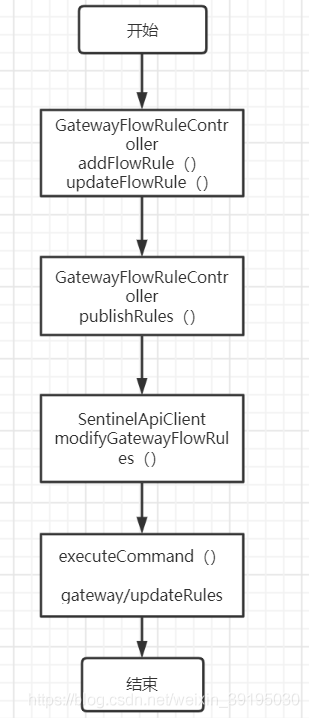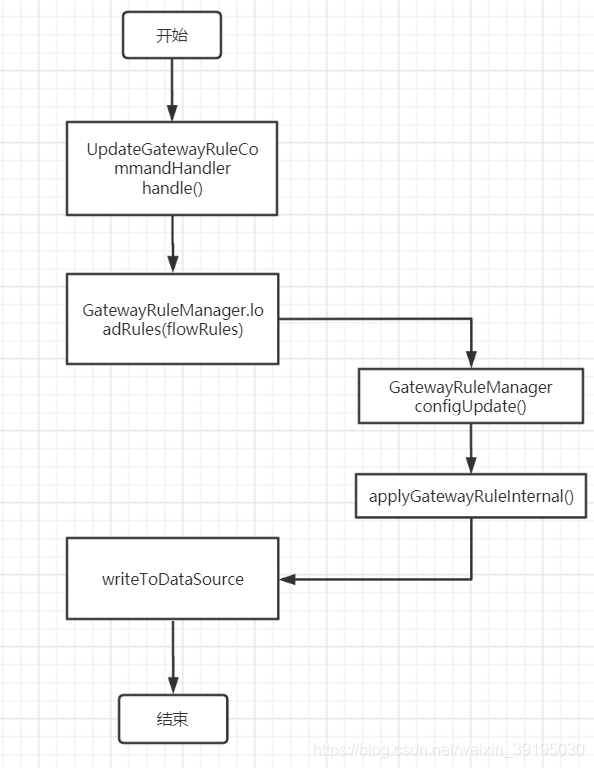Sentinel Dashboard限流规则保存
sentinel在限流规则配置方面提供了可视化页面 sentinel dashboard,源码可从github下载,请自行搜索,此处不提供下载链接。
规则持久化后首先触发GatewayFlowRuleController(源码似乎没有,请参考普通规则改造)的/new.json(或)请求,方法会调用publishRules()将本次编辑规则组装后通过远程调用请求gateway/updateRules更新远程服务内存中限流规则,该接口由远程服务UpdateGatewayRuleCommandHandler提供。
UpdateGatewayRuleCommandHandler接收到请求通过调用handle方法,方法通过
Set<GatewayFlowRule> flowRules = (Set)JSON.parseObject(data, new TypeReference<Set<GatewayFlowRule>>() {
}, new Feature[0]);
GatewayRuleManager.loadRules(flowRules);
将规则持久化到内存。
具体请参考以下流程图
Sentinel DashBoard程序流程

Gateway网关程序流程

sentinel dashboard 限流规则持久化到nacos
1、将webapp/resources/app/scripts/directives/sidebar/sidebar.html中的
<li ui-sref-active="active">
<a ui-sref="dashboard.flowV1({app: entry.app})">
<i class="glyphicon glyphicon-filter"></i> 流控规则
</a>
</li>
改为:
<li ui-sref-active="active">
<a ui-sref="dashboard.flow({app: entry.app})">
<i class="glyphicon glyphicon-filter"></i> 流控规则
</a>
</li>
2、将webapp\resources\app\scripts\controllers\identity.js中的(主要是将FlowServiceV1改为FlowServiceV2)
app.controller('IdentityCtl', ['$scope', '$stateParams', 'IdentityService',
'ngDialog', 'FlowServiceV1', 'DegradeService', 'AuthorityRuleService', 'ParamFlowService', 'MachineService',
'$interval', '$location', '$timeout',
function ($scope, $stateParams, IdentityService, ngDialog,
FlowService, DegradeService, AuthorityRuleService, ParamFlowService, MachineService, $interval, $location, $timeout) {
改为:
app.controller('IdentityCtl', ['$scope', '$stateParams', 'IdentityService',
'ngDialog', 'FlowServiceV2', 'DegradeService', 'AuthorityRuleService', 'ParamFlowService', 'MachineService',
'$interval', '$location', '$timeout',
function ($scope, $stateParams, IdentityService, ngDialog,
FlowService, DegradeService, AuthorityRuleService, ParamFlowService, MachineService, $interval, $location, $timeout) {
3、将下面的四个文件全部拷贝到src/main/java的com.alibaba.csp.sentinel.dashboard.rule包下
FlowRuleNacosProvider.java (从nacos读取配置)
package com.alibaba.csp.sentinel.dashboard.rule;
import java.util.ArrayList;
import java.util.List;
import com.alibaba.csp.sentinel.dashboard.datasource.entity.rule.FlowRuleEntity;
import com.alibaba.csp.sentinel.dashboard.rule.DynamicRuleProvider;
import com.alibaba.csp.sentinel.datasource.Converter;
import com.alibaba.csp.sentinel.util.StringUtil;
import com.alibaba.nacos.api.config.ConfigService;
import org.springframework.beans.factory.annotation.Autowired;
import org.springframework.stereotype.Component;
@Component("flowRuleNacosProvider")
public class FlowRuleNacosProvider implements DynamicRuleProvider<List<FlowRuleEntity>> {
@Autowired
private ConfigService configService;
@Autowired
private Converter<String, List<FlowRuleEntity>> converter;
@Override
public List<FlowRuleEntity> getRules(String appName) throws Exception {
// app端如果需要读取在此处设置好的配置需要设置的GROUP和dataId 需要和这里保持一致
String group = NacosConfigUtil.GROUP_ID;
String dataId = appName + NacosConfigUtil.FLOW_DATA_ID_POSTFIX;
String rules = configService.getConfig(dataId, group, 3000);
if (StringUtil.isEmpty(rules)) {
return new ArrayList<>();
}
return converter.convert(rules);
}
}
FlowRuleNacosPublisher.java (将修改后的配置同步到nacos)
package com.alibaba.csp.sentinel.dashboard.rule;
import java.util.List;
import com.alibaba.csp.sentinel.dashboard.datasource.entity.rule.FlowRuleEntity;
import com.alibaba.csp.sentinel.dashboard.rule.DynamicRulePublisher;
import com.alibaba.csp.sentinel.datasource.Converter;
import com.alibaba.csp.sentinel.util.AssertUtil;
import com.alibaba.nacos.api.config.ConfigService;
import org.springframework.beans.factory.annotation.Autowired;
import org.springframework.stereotype.Component;
@Component("flowRuleNacosPublisher")
public class FlowRuleNacosPublisher implements DynamicRulePublisher<List<FlowRuleEntity>> {
@Autowired
private ConfigService configService;
@Autowired
private Converter<List<FlowRuleEntity>, String> converter;
@Override
public void publish(String app, List<FlowRuleEntity> rules) throws Exception {
AssertUtil.notEmpty(app, "app name cannot be empty");
if (rules == null) {
return;
}
//需要和FlowRuleNacosProvider保持一致
String group = NacosConfigUtil.GROUP_ID;
String dataId = appName + NacosConfigUtil.FLOW_DATA_ID_POSTFIX;
configService.publishConfig(dataId , group , converter.convert(rules));
}
}
NacosConfig.java(初始化nacos的nacosConfigService)
package com.alibaba.csp.sentinel.dashboard.rule;
import java.util.List;
import com.alibaba.csp.sentinel.dashboard.datasource.entity.rule.DegradeRuleEntity;
import com.alibaba.csp.sentinel.dashboard.datasource.entity.rule.FlowRuleEntity;
import com.alibaba.csp.sentinel.datasource.Converter;
import com.alibaba.fastjson.JSON;
import com.alibaba.nacos.api.config.ConfigFactory;
import com.alibaba.nacos.api.config.ConfigService;
import org.springframework.context.annotation.Bean;
import org.springframework.context.annotation.Configuration;
@Configuration
public class NacosConfig {
@Bean
public Converter<List<FlowRuleEntity>, String> flowRuleEntityEncoder() {
return JSON::toJSONString;
}
@Bean
public Converter<String, List<FlowRuleEntity>> flowRuleEntityDecoder() {
return s -> JSON.parseArray(s, FlowRuleEntity.class);
}
@Bean
public Converter<List<DegradeRuleEntity>, String> degradeRuleEntityEncoder() {
return JSON::toJSONString;
}
@Bean
public Converter<String, List<DegradeRuleEntity>> degradeRuleEntityDecoder() {
return s -> JSON.parseArray(s, DegradeRuleEntity.class);
}
@Bean
public ConfigService nacosConfigService() throws Exception {
//在此处设置nacos服务器的地址
return ConfigFactory.createConfigService("localhost:8848");
}
}
NacosConfigUtil.java(nacos配置的一些常量)
package com.alibaba.csp.sentinel.dashboard.rule;
public final class NacosConfigUtil {
public static final String GROUP_ID = "SENTINEL_GROUP";
public static final String FLOW_DATA_ID_POSTFIX = "-flow-rules";
public static final String PARAM_FLOW_DATA_ID_POSTFIX = "-param-rules";
public static final String CLUSTER_MAP_DATA_ID_POSTFIX = "-cluster-map";
public static final String DEGRADE_DATA_ID_POSTFIX = "-degrade-rules";
/**
* cc for `cluster-client`
*/
public static final String CLIENT_CONFIG_DATA_ID_POSTFIX = "-cc-config";
/**
* cs for `cluster-server`
*/
public static final String SERVER_TRANSPORT_CONFIG_DATA_ID_POSTFIX = "-cs-transport-config";
public static final String SERVER_FLOW_CONFIG_DATA_ID_POSTFIX = "-cs-flow-config";
public static final String SERVER_NAMESPACE_SET_DATA_ID_POSTFIX = "-cs-namespace-set";
private NacosConfigUtil() {}
}
4、修改com.alibaba.csp.sentinel.dashboard.controller.v2.FlowControllerV2
将
@Autowired
@Qualifier("flowRuleDefaultProvider")
private DynamicRuleProvider<List<FlowRuleEntity>> ruleProvider;
@Autowired
@Qualifier("flowRuleDefaultPublisher")
private DynamicRulePublisher<List<FlowRuleEntity>> rulePublisher;
改为:
@Autowired
@Qualifier("flowRuleNacosProvider")
private DynamicRuleProvider<List<FlowRuleEntity>> ruleProvider;
@Autowired
@Qualifier("flowRuleNacosPublisher")
private DynamicRulePublisher<List<FlowRuleEntity>> rulePublisher;
然后启动之后就可以测试了
以上为个人经验,希望能给大家一个参考,也希望大家多多支持自学编程网。

- 本文固定链接: https://zxbcw.cn/post/215954/
- 转载请注明:必须在正文中标注并保留原文链接
- QQ群: PHP高手阵营官方总群(344148542)
- QQ群: Yii2.0开发(304864863)
